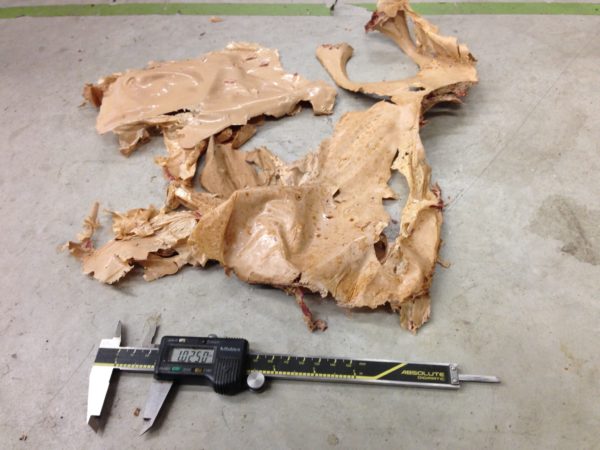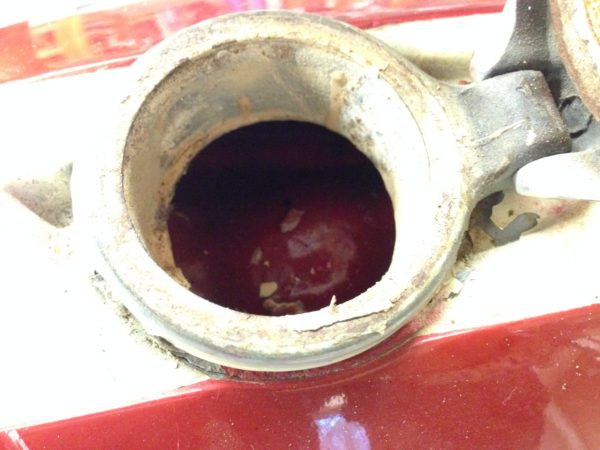The fiberglass tank had a liner in it when I purchased the bike. It was flaking around the filler and I didn’t trust it to protect the fiberglass from modern ethanol laced gas. After the tank set for a few weeks with race gas, I noticed the liner was peeling away from the sides of the tank. The entire liner came out when I pulled on it.


Hi Dave,
I’m also a friend of Doug Lent – purchased some rare Rickman parts from him that I needed for a Rickman Metisse MkIV Yamaha DT restoration; while there I also came home with another Rickman. These projects are sitting alongside my MkIII BSA A65 Metisse that I’ve had a long time.
I was bugging Doug with a question about fiberglass tank liners and he told me to get lost and contact Dave… so I am. I haven’t ridden my BSA in a few years and I took it apart to polish the nickel frame and replace oil and gas lines. The tank had the cap off but still had a strong fuel odor. I boroscoped it and found a gummy spot in the back of the tank. Hmmm. I only ran auto fuel rarely when I didn’t have avgas handy. I normally drained the tank if it was going to sit any length of time, but somehow I must have left a bit in there and it attacked the old fiberglass resin. The tank was never lined. In the past on fiberglass tanks I’ve used Caswell sealer and an aircraft tank sealer I’m familiar with. In this case I don’t want to use a product like Caswell over a soft spot.
My thought was to flush the tank with water and detergent, let it dry, and put some Xylene in to let it scour that spot. If that clears up the gummy spot I thought I could pour a resin in to set up over that spot. If every thing looks good then try Caswell. I might not even use a liner at all if I can find a local shop selling no-alcohol fuel, apparently there are still a few here in Maryland. Doug used quite colorful language to describe how dumb this idea was.
He mentioned that he brings his fiberglass challenges to you and urged me to ask your advice. Any thoughts on how to cure a soft spot in an otherwise perfect tank. I have three more Rickman fiberglass tanks to worry about next!
Your restorations all look amazing. I restore machines of all types for relaxation from my stressful job – I hope I can achieve your results!
Cheers,
Liam
Hi Liam, Thanks for complements. I did something similar to what you’re describing to the fiberglass tank of my BSA 441 Shooting Star. It had a failed liner and there were a couple of seam cracks where it was weeping gas. To get the liner out, I cut a large opening in the bottom of the tank and spent several days with solvents getting all of the old liner out. After letting it dry for a while, I then painted several thick coats of gasoline resistant epoxy on the inside of the tank. I finished the job by fiberglassing the bottom of the tank back in place and then did a final pour-in coat of epoxy. I haven’t tried using the tank since repairing it so I don’t know if the repair is good.
Before doing this repair I did a lot of googling and perusing BSA forums. The opinion I came away with is that coating the inside of an old fiberglass tank with pour-in epoxy (if done well) may last a few years, but I don’t recall anyone claiming to have found it a permanent fix.
The website https://www.pure-gas.org might be a resource to help you locate ethanol free fuel near you. Near me, aviation gas is the best affordable option.
Good luck with the repair, I hope you’re successful.
Regards,
David